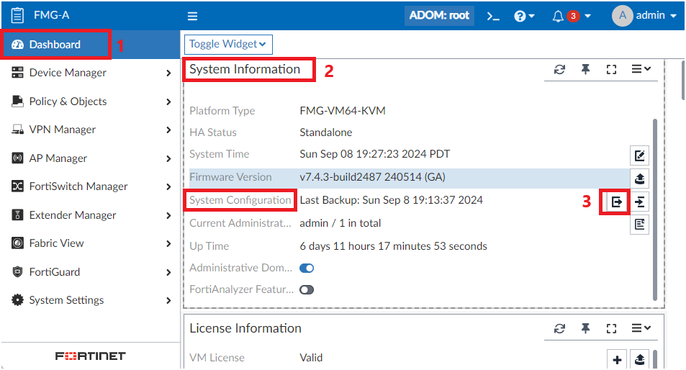- Support Forum
- Knowledge Base
- Customer Service
- Internal Article Nominations
- FortiGate
- FortiClient
- FortiADC
- FortiAIOps
- FortiAnalyzer
- FortiAP
- FortiAuthenticator
- FortiBridge
- FortiCache
- FortiCare Services
- FortiCarrier
- FortiCASB
- FortiConverter
- FortiCNP
- FortiDAST
- FortiData
- FortiDDoS
- FortiDB
- FortiDNS
- FortiDLP
- FortiDeceptor
- FortiDevice
- FortiDevSec
- FortiDirector
- FortiEdgeCloud
- FortiEDR
- FortiEndpoint
- FortiExtender
- FortiGate Cloud
- FortiGuard
- FortiGuest
- FortiHypervisor
- FortiInsight
- FortiIsolator
- FortiMail
- FortiManager
- FortiMonitor
- FortiNAC
- FortiNAC-F
- FortiNDR (on-premise)
- FortiNDRCloud
- FortiPAM
- FortiPhish
- FortiPortal
- FortiPresence
- FortiProxy
- FortiRecon
- FortiRecorder
- FortiSRA
- FortiSandbox
- FortiSASE
- FortiSASE Sovereign
- FortiScan
- FortiSIEM
- FortiSOAR
- FortiSwitch
- FortiTester
- FortiToken
- FortiVoice
- FortiWAN
- FortiWeb
- FortiAppSec Cloud
- Lacework
- Wireless Controller
- RMA Information and Announcements
- FortiCloud Products
- ZTNA
- 4D Documents
- Customer Service
- Community Groups
- Blogs
- Fortinet Community
- Knowledge Base
- FortiAnalyzer
- Technical Tip: Migrating FortiManager/FortiAnalyze...
- Subscribe to RSS Feed
- Mark as New
- Mark as Read
- Bookmark
- Subscribe
- Printer Friendly Page
- Report Inappropriate Content
| Description |
This article describes how to migrate FortiManager or FortiAnalyzer to a different platform. These article's steps are intended for migration between different platforms such as a different hardware model, different VM environments, or from hardware to a VM. |
| Scope | FortiManager, FortiAnalyzer. |
| Solution |
Note: In the case of migrating between VM environments, 'exec restore' can be used instead of 'exec migrate' to load the configuration. This allows for system settings to be copied over. The license can run on 2 systems at the same time for a grace period of 7 days.
Config migration:
execute backup all-settings {ftp | sftp} <ip:port> <path/filename> <username> <password> <crptpasswd>
execute backup all-settings sftp 192.168.1.100:22 /home/fortinet/Downloads/ username password backup-file-pwd # Starting transfer the backup file to SFTP server...
Note: It is mandatory to enter the password <crptpasswd> for the backup file in the latest firmware version.
This step is only applicable when migrating between VM platforms.

execute migrate all-settings <ftp/scp/sftp> <server ip> <path/filename> <username> <password> <crptpasswd>
execute migrate all-settings sftp 192.168.1.100:22 /home/fortinet/Downloads/backup.dat username password backup-file-pwd This operation will replace the current databases and reboot the system. Starting transfer the backup file from SFTP server...
Technical Tip: Backup and restore of FortiAnalyzer settings, logs and reports
execute backup logs <device name(s)| all> <ftp/sftp/scp> <ip> <user name> <password> <directory> execute backup reports <report name or all> <ftp/sftp/scp> <ip> <user name> <password> <directory>
execute restore logs <device name(s)| all> <ftp/sftp/scp> <ip> <user name> <password> <directory> execute restore reports <report name or all> <ftp/sftp/scp> <ip> <user name> <password> <directory>
execute sql-local rebuild-db
diagnose sql status rebuild-db
Update FortiGate configuration settings:
For FortiAnalyzer:
execute batch start config log fortianalyzer setting set server <<new FAZ IP address>> set serial <<new FAZ serial number>> end
fnsysctl killall miglogd
For FortiManager:
execute batch start config system central-management set fmg <<new FMG IP address>> set serial-number <<new FMG serial number>> end execute batch end
fnsysctl killall fgfmd
execute fgfm reclaim-dev-tunnel --> For all managed FortiGates. execute fgfm reclaim-dev-tunnel <device_name> force --> For specific FortiGate.
Note: When a large number of FortiGates need to be migrated, using the original FortiManager to run a CLI script to change the central-management IP and serial number would be useful. The CLI script should be run with the target as 'Remote FortiGate Directly (via CLI)'.
Related article: Technical Tip: Using exec migrate to migrate to a new FortiAnalyzer/FortiManager model |
The Fortinet Security Fabric brings together the concepts of convergence and consolidation to provide comprehensive cybersecurity protection for all users, devices, and applications and across all network edges.
Copyright 2025 Fortinet, Inc. All Rights Reserved.


